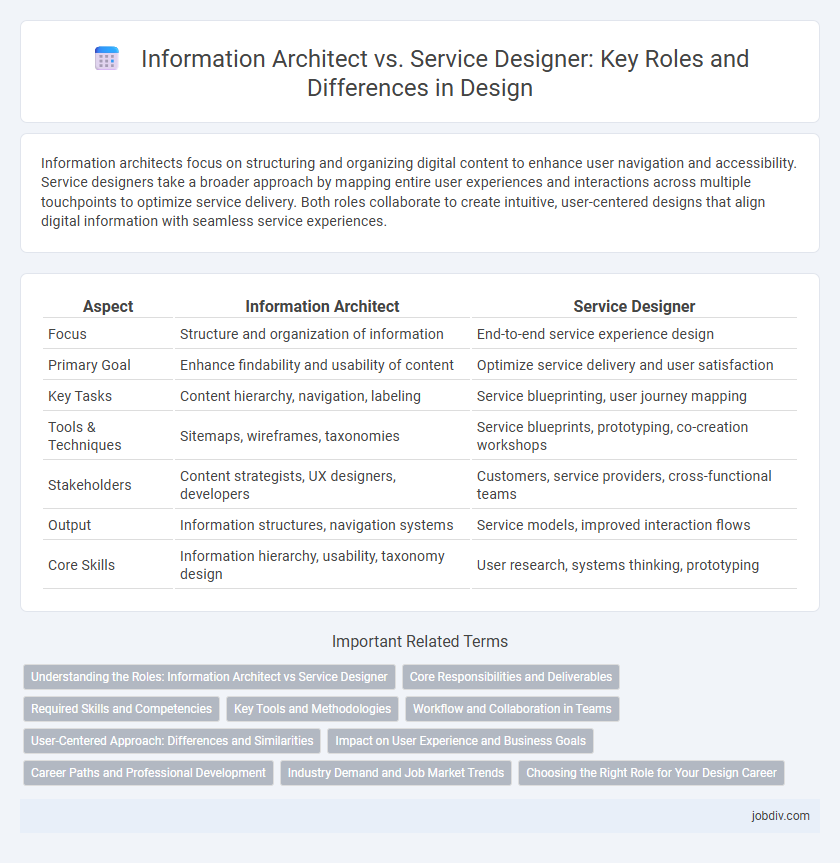Information architects focus on structuring and organizing digital content to enhance user navigation and accessibility. Service designers take a broader approach by mapping entire user experiences and interactions across multiple touchpoints to optimize service delivery. Both roles collaborate to create intuitive, user-centered designs that align digital information with seamless service experiences.
Table of Comparison
| Aspect | Information Architect | Service Designer |
|---|---|---|
| Focus | Structure and organization of information | End-to-end service experience design |
| Primary Goal | Enhance findability and usability of content | Optimize service delivery and user satisfaction |
| Key Tasks | Content hierarchy, navigation, labeling | Service blueprinting, user journey mapping |
| Tools & Techniques | Sitemaps, wireframes, taxonomies | Service blueprints, prototyping, co-creation workshops |
| Stakeholders | Content strategists, UX designers, developers | Customers, service providers, cross-functional teams |
| Output | Information structures, navigation systems | Service models, improved interaction flows |
| Core Skills | Information hierarchy, usability, taxonomy design | User research, systems thinking, prototyping |
Understanding the Roles: Information Architect vs Service Designer
Information Architects specialize in organizing and structuring information to enhance usability, focusing on navigation, content hierarchy, and labeling systems within digital products. Service Designers map and improve end-to-end customer experiences by aligning people, processes, and touchpoints across multiple channels to optimize service delivery. Understanding these roles highlights how Information Architects deal with content clarity while Service Designers address holistic user interactions and service ecosystems.
Core Responsibilities and Deliverables
Information Architects focus on organizing, structuring, and labeling digital content to enhance user navigation, producing sitemaps, wireframes, and taxonomies as key deliverables. Service Designers concentrate on designing holistic user experiences by mapping customer journeys, identifying touchpoints, and improving service workflows, with journey maps, service blueprints, and prototypes as primary outputs. Both roles collaborate to ensure seamless digital and service interactions, but Information Architects specialize in content clarity, whereas Service Designers prioritize end-to-end service efficiency.
Required Skills and Competencies
Information Architects require skills in user research, data modeling, and wireframing to structure and organize digital content effectively. Service Designers focus on customer journey mapping, stakeholder collaboration, and service blueprinting to create seamless and holistic service experiences. Both roles demand strong analytical thinking and proficiency in design tools but emphasize different aspects of user experience and service delivery.
Key Tools and Methodologies
Information Architects employ tools like card sorting, wireframing, and user flow diagrams to structure content and optimize navigation. Service Designers utilize journey mapping, blueprinting, and stakeholder workshops to design holistic user experiences across touchpoints. Both disciplines leverage prototyping and user research to validate and refine their designs for enhanced usability and engagement.
Workflow and Collaboration in Teams
Information architects optimize workflow by structuring content and defining user pathways to ensure intuitive navigation and efficient information retrieval. Service designers map end-to-end service experiences, coordinating multidisciplinary teams to align touchpoints and streamline cross-functional collaboration. Both roles enhance teamwork by clarifying responsibilities and integrating user insights into cohesive design processes.
User-Centered Approach: Differences and Similarities
Information Architects focus on structuring and organizing content to ensure intuitive navigation and effective information retrieval, optimizing the user experience through clear hierarchy and labeling. Service Designers take a broader approach by mapping end-to-end user journeys and aligning touchpoints across multiple channels to create seamless interactions and fulfill user needs holistically. Both disciplines prioritize user-centered design by deeply understanding user behaviors, pain points, and goals, but Information Architects concentrate more on content clarity while Service Designers emphasize overall service flow and integration.
Impact on User Experience and Business Goals
Information Architects structure data and content to enhance findability and usability, directly improving user experience by simplifying navigation and reducing cognitive load. Service Designers create end-to-end service blueprints that align user interactions with business objectives, fostering seamless, efficient experiences that drive customer satisfaction and loyalty. Combining both roles optimizes digital products by ensuring organized information flow while delivering holistic services that meet strategic business goals.
Career Paths and Professional Development
Information Architects focus on organizing and structuring digital content to enhance user experience, often requiring expertise in user research, content strategy, and interaction design. Service Designers take a broader approach by designing end-to-end service experiences, integrating touchpoints across multiple channels with skills in customer journey mapping, stakeholder collaboration, and business strategy. Career development for Information Architects typically involves progressing toward UX design or content strategy leadership, while Service Designers may advance into roles such as service innovation managers or experience directors, emphasizing cross-disciplinary collaboration and strategic impact.
Industry Demand and Job Market Trends
The demand for Information Architects remains steady as companies prioritize user experience and efficient data structuring, particularly in tech and digital sectors. Service Designers are experiencing accelerated growth, driven by businesses seeking holistic solutions that enhance customer journeys and integrate cross-channel services. Job market trends indicate a rising preference for professionals who combine both skill sets, reflecting the industry's shift towards comprehensive design strategies that encompass both information flow and service delivery.
Choosing the Right Role for Your Design Career
Information Architects specialize in structuring and organizing digital content to enhance user navigation and accessibility, while Service Designers focus on creating seamless end-to-end experiences across touchpoints, integrating both digital and physical interactions. Choosing between these roles depends on your passion for either optimizing information flow or designing holistic service ecosystems that balance user needs and business goals. Evaluating specific career objectives and strengths in system thinking versus user journey mapping helps determine the best fit in the evolving design industry.
Information Architect vs Service Designer Infographic

 jobdiv.com
jobdiv.com